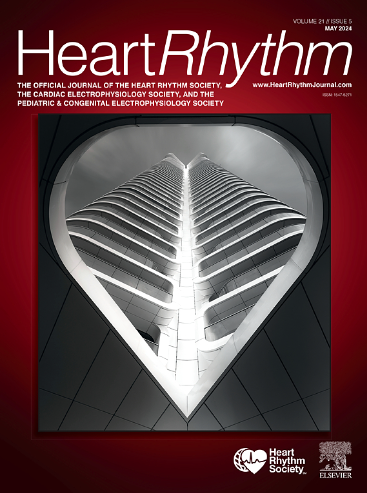小鼠妊娠期心律失常性心房重塑。
IF 5.7
2区 医学
Q1 CARDIAC & CARDIOVASCULAR SYSTEMS
引用次数: 0
摘要
背景:妊娠与更易发生室上性快速性心律失常(SVT)有关:由于其潜在机制仍有待阐明,我们研究了妊娠是否会诱发心房重塑,从而导致心房重塑:方法:研究了非妊娠(NP)和妊娠(P)小鼠的心房电生理和收缩特性。测量了心房肌细胞的细胞缩短和 Ca2+ 成像。使用膜片钳技术记录心房动作电位和离子电流。使用 qPCR 和 Western 印迹分析心房 mRNA 和蛋白质的表达:结果:妊娠期心电图上的 P 波面积增加了 50%,表明心房增大,超声心动图证实了这一点。P 型小鼠的心房肌细胞更长,进一步证明了与妊娠有关的生理性肥大。超声心动图显示,妊娠期间心房分区面积变化增加了 50%,表明收缩力更强。在妊娠小鼠中也观察到类似的细胞缩短增加,这与肌节长度的减少和肌丝蛋白磷酸化的变化有关。然而,妊娠并不影响 L 型 Ca2+ 电流、Ca2+ 瞬态和 SR Ca2+ 负荷。妊娠小鼠的肌细胞自发收缩和自发舒张期 Ca2+ 释放的次数是正常小鼠的两倍。此外,妊娠与动作电位持续时间增加 50%有关,这与瞬时外向 K+ 电流 Ito 和基本 KV4.3 通道密度降低有关:结论:妊娠期间,心房组织发生了重大重塑,可能会导致室上性心动过速的发生。本文章由计算机程序翻译,如有差异,请以英文原文为准。

Arrhythmogenic atrial remodeling during pregnancy in mice
Background
Pregnancy is associated with greater vulnerability to supraventricular tachyarrhythmias.
Objective
As the underlying mechanisms remain to be elucidated, we investigated whether pregnancy induces atrial remodeling that might contribute to this.
Methods
Atrial electrophysiological and contractile properties were examined in nonpregnant and pregnant (P) mice. Cell shortening and Ca2+ imaging were measured on atrial myocytes. Atrial action potential and ionic currents were recorded using the patch-clamp technique. Atrial messenger RNA and protein expression were analyzed using quantitative polymerase chain reaction and Western blot.
Results
The P-wave area on the electrocardiogram increased by 50% during pregnancy, suggesting atrial enlargement, confirmed by echocardiography. The atrial myocytes were longer in P mice, adding further evidence to the physiological hypertrophy associated with pregnancy. Echocardiography showed a 50% increase in atrial fractional area change during pregnancy, indicating much stronger contraction. A similar increase in cell shortening was observed in P mice and was associated with a decrease in sarcomere length and changes in myofilament protein phosphorylation. However, pregnancy did not affect L-type Ca2+ current, Ca2+ transients, and SR Ca2+ load. Myocytes from P mice showed twice as many spontaneous contractions and spontaneous diastolic Ca2+ releases. Moreover, pregnancy was associated with a 50% increase in action potential duration, linked to a reduction in the density of the Ca2+-independent transient outward K+ current and the underlying KV4.3 channel.
Conclusion
During pregnancy, atrial tissues undergo substantial remodeling, potentially contributing to the development of supraventricular tachyarrhythmias.
求助全文
通过发布文献求助,成功后即可免费获取论文全文。
去求助
来源期刊

Heart rhythm
医学-心血管系统
CiteScore
10.50
自引率
5.50%
发文量
1465
审稿时长
24 days
期刊介绍:
HeartRhythm, the official Journal of the Heart Rhythm Society and the Cardiac Electrophysiology Society, is a unique journal for fundamental discovery and clinical applicability.
HeartRhythm integrates the entire cardiac electrophysiology (EP) community from basic and clinical academic researchers, private practitioners, engineers, allied professionals, industry, and trainees, all of whom are vital and interdependent members of our EP community.
The Heart Rhythm Society is the international leader in science, education, and advocacy for cardiac arrhythmia professionals and patients, and the primary information resource on heart rhythm disorders. Its mission is to improve the care of patients by promoting research, education, and optimal health care policies and standards.
 求助内容:
求助内容: 应助结果提醒方式:
应助结果提醒方式:


